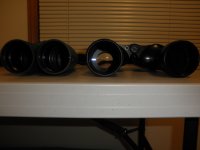I know an 8x56 is not normally the size of binocular most birders use, but I have been comparing two good 8x56's a Meopta Meostar B1 8x56 and a Docter Nobilem B 8x56 to a Nikon SE 8x32, Swarovski Habicht 8x30, and a Swift Audubon 804 8.5x44 under different lighting conditions, and I am very impressed with the 8x56. I know the 8x56 has the advantage of a bigger exit pupil, so it is going to be brighter especially under low light and eye placement will also be easier, but it goes beyond those two things.
The two 8x56's also have a big advantage with glare under difficult lighting situations, they have better contrast seeming to almost cut through difficult lighting situations, and they are sharper because they use the sweet spot of the bigger aperture avoiding aberrations at the edge as in a 42 mm similar to a stopped down binocular. The glare resistance of the big aperture 56 mm is a bigger advantage than you might think because you can use it at sun up and sun down without so much as a smidgen of glare to spoil the view. The bigger exit pupil of the 8x56 handles glare better because the reflections from the edge of the objective never enter the eye. These two 8x56 binoculars only have a 6.4 degree FOV, so they can't compete with the Swarovski NL or Zeiss SF when it comes to FOV, but that is not the point.
The point is they have a higher quality FOV with no glare, they are sharper with less optical aberrations, and they are brighter under almost any light except maybe full sunlight and I have had the NL and SF in 42 mm apertures. As you move up in aperture from a 20 mm to a 56 mm, each step up gives you a slight improvement in performance but moving up to a 56 mm gives you a huge leap in performance even over a 42 mm because you are increasing your aperture size geometrically.
A bigger aperture helps you even in the daytime because it controls glare better, which gives you better contrast. In astronomy, they always say aperture rules, but I am beginning to think it applies to birding also. Again, not many birders will carry a 40 oz. 8x56 binocular hiking, and I fully understand that. I still think for most birders a good 8x32 or 8x42 is best, but a big 8x56 certainly spoils you with the view. When you are used to using an 8x56, it is hard to back to an 8x32 or even an 8x42.


The two 8x56's also have a big advantage with glare under difficult lighting situations, they have better contrast seeming to almost cut through difficult lighting situations, and they are sharper because they use the sweet spot of the bigger aperture avoiding aberrations at the edge as in a 42 mm similar to a stopped down binocular. The glare resistance of the big aperture 56 mm is a bigger advantage than you might think because you can use it at sun up and sun down without so much as a smidgen of glare to spoil the view. The bigger exit pupil of the 8x56 handles glare better because the reflections from the edge of the objective never enter the eye. These two 8x56 binoculars only have a 6.4 degree FOV, so they can't compete with the Swarovski NL or Zeiss SF when it comes to FOV, but that is not the point.
The point is they have a higher quality FOV with no glare, they are sharper with less optical aberrations, and they are brighter under almost any light except maybe full sunlight and I have had the NL and SF in 42 mm apertures. As you move up in aperture from a 20 mm to a 56 mm, each step up gives you a slight improvement in performance but moving up to a 56 mm gives you a huge leap in performance even over a 42 mm because you are increasing your aperture size geometrically.
A bigger aperture helps you even in the daytime because it controls glare better, which gives you better contrast. In astronomy, they always say aperture rules, but I am beginning to think it applies to birding also. Again, not many birders will carry a 40 oz. 8x56 binocular hiking, and I fully understand that. I still think for most birders a good 8x32 or 8x42 is best, but a big 8x56 certainly spoils you with the view. When you are used to using an 8x56, it is hard to back to an 8x32 or even an 8x42.


Last edited:







